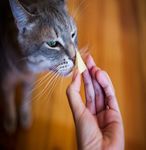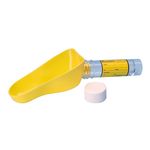TRAVEL WITH YOUR PET ABROAD FROM 1ST JANUARY 2021 - Dalehead Veterinary Group
←
→
Page content transcription
If your browser does not render page correctly, please read the page content below
Tel: (01729) 823538
www.daleheadvetgroup.co.uk
Companion Animal Newsletter - January 2021
TRAVEL WITH YOUR PET ABROAD FROM 1ST JANUARY 2021
To travel with your pet dog, cat or ferret to the EU from 01/01/2021 you will now need 2 visits to the surgery.
1. A microchip and rabies vaccination appointment more than 3 weeks before travel (unless already done), and a rabies
booster within every 3 years. The rabies vaccination certificate (e.g. Pet Passport) must travel with your pet.
2. An Animal Health Certificate (AHC) appointment within 10 days of travel. A new AHC is needed for each trip from Great
Britain to EU and Northern Ireland. Each AHC can be used for up to 4 months onward travel to other countries within the
EU and return to the UK.
3. A tapeworm treatment is needed before travel from Britain to Northern Ireland, Ireland, Finland, Norway, Malta, and will
be given at the Animal Health Certificate appointment.
4. Animal Health Certificate’s are for non-commercial movements of no more than 5 pets accompanied by their owner (or
person authorised by the owner in writing) who must also accompany the pets for the Animal Health Certificate
appointment within 10 days of travel to sign the form.
5. As the UK is now a ‘listed third country’ a rabies blood test is now not needed to enter the EU (as long as your pet has not
lived outside of the UK or EU).
6. A tapeworm treatment is needed (as before) between 1 and 5 days before return to the UK (apart from Northern
Ireland, Ireland, Finland, Norway, Malta).
7. Documents needed to take with your pet:
• Rabies Vaccination Card
• Animal Health Certificate
• Owner Declaration – part of the Animal Health Certificate
• Authorisation in writing of nominated person to accompany animal if not the
owner.
COVID19 UPDATE
Following the Prime Minister’s announcement on Monday evening and the subsequent lockdown the BVA and RCVS have issued a joint
statement giving veterinary professionals guidance on how they can continue to provide essential services required for the health of your
pets. Whilst it is not ’business as usual’, the social distancing measures that we have in place at the surgery allow our staff to work safely and
maintain social distancing from you, the client. We MUST ALL do our very best to stay safe and with this in mind we would like to politely
request the following:
• Clients MUST wear a FACE MASK when attending the surgery, both when speaking to the vets/nurses and the reception team at the
front doors
• BRING your MOBILE PHONE with you and when you get to the surgery please telephone our reception to let us know you have
arrived, and inform the receptionist of the number you are on. Keep it on your person so that the vet or nurse can speak to you
remotely when they have examined your pet to discuss treatment options and also so that the reception team can take your
payment over the telephone without having to come to the door where possible
• If you or any member of your household have tested positive for Covid19, are displaying symptoms or are self-isolating, PLEASE do
not come to the surgery. Contact us to arrange an alternative appointment when you are well.WALKING YOUR DOG AT NIGHT
Many of us lead busy lives and during the winter months walking our dogs during the hours of darkness is often the only
option. So to keep us all safe we have several dog walking in the dark safety measures.
Potential hazards when walking your dog at night
• Moving vehicles
• Potholes and other trip hazards
• Other dogs
• Other walkers or runners
• Cyclists
When walking your dog in the dark, there are two simple things you
can do to make your walks easier and keep yourself safe. These are:
• Always carry a torch, or better still, wear a head torch, as this will leave your hands free for lead and poo bag duties.
• Wear bright reflective clothing. It’s equally important you wear a bright coat, ideally one with reflectors. Remember
See and be Seen!
How do I keep my dog safe when walking in the dark?
Obviously when its dark and we allow our dogs off the lead, we are far more likely to lose them, which could lead to a
mishap resulting in a visit to the vets. However, there are lots of products available which allow us to keep an eye on our
four legged friends. These include:
• Reflective Gear: Reflective collars, leads and coats are advisable for your dog along with a reflective coat or gilet for
yourself.
• LED lights: These lights are now lighter and brighter than ever and batteries last much longer or can be recharged via a
USB. They come in various designs including collars or clip on tags.
Things to be aware of when walking your dog at night
Familiarity helps, so if you plan on taking your dog on a new walking route you should try to do it in daylight first. Other
things to consider are:
• Cars and other vehicles: Road traffic accidents are a common cause of emergency admissions, particularly during the
hours of darkness.
• Potholes and other objects: Be aware of broken glass and other sharp objects which can injure your dog’s feet. Lively
dogs may also attempt to jump over fences or walls and may be unable to see the depth or the drop on the other side,
or other hazards like barbed wire.
• Other dogs: Meeting other dogs is more of an issue in the dark, so if your pet is nervous it’s probably best to keep them
on a lead or within sight
• Other people: Consider joggers on paths and cyclists on bridleways.
Please call at our Settle surgery to enquire about our ‘BRIGHT’ product selection.
Keeping rabbits warm is important, in the wild they live in underground
burrows where the temperature changes only slightly between summer and
winter. Keeping rabbits above ground exposes them to extreme temperature
changes. Damp and draughts can be fatal at this time of the year for rabbits.
Garden sheds offer a great alternative to a traditional rabbit hutch as they can
be well insulated, keep the rabbits nice and dry as well as allowing room to
exercise. External runs can still be attached to a shed and covered by a
tarpaulin. Many owners bring their rabbits inside during the colder months either in a shed, garage or into the house. If
you decide to bring your rabbits inside it is important to keep them inside until spring or until the weather has warmed up.
Rabbits will lose their winter coats and placing them back into the cold can be fatal. If you are unable to bring your rabbit
into an indoor space, insulating hutches, supplying a large amount of clean, dry bedding, using heated pads as well as
proofing the hutch from drafts will enable your rabbit to keep warm. Your rabbit will develop a winter coat which will also
help keep them cosy.
This advice is for rabbits who are in good body condition. Those who are old or thin may need even more care and we
advise owners of such bunnies to bring them in for the winter.WHY DO WE ......EXAMINE URINE SAMPLES?
Examining a urine sample is not everyone's idea of fun but it can give us a lot of
information for such a small non-invasive diagnostic test. It can sometimes seem daunting
to try and get a urine sample from your pet but it’s not really that bad. A few handy tips
include
• A Fresh sample (preferable the first wee of the day). This urine will have sat in the
bladder all night so gives a good sample.
• A clean container (nothing that has had fat or sugar in it. Despite being washed out well residues can interfere with the
urine results)
• If you do see blood in the urine it is really helpful to note whether it’s at the start, the middle or comes at the end of
urination. This helps us narrow down where it might be coming from.
• Finally try to note if there’s any straining to urinate, needing to go but not producing much, and whether the stream of
urine is flowing well.
How do we test the urine and what are we checking for?
• Dipstick
Much like you may see the doctors using this is a quick test to check for things such
as glucose, ketones, blood (that is often not visible to the human eye). It provides a
signpost for the vet to decide whether further testing may be necessary.
• Specific gravity
In simple terms this is where we check the strength of the urine against a set range for the
species being tested. For example, urine that is very dilute or too strong could mean a urine
infection or kidney trouble etc
• Microscopy
This is where the urine is spun in a centrifuge to separate the particles from the liquid. It gives
a more concentrated sample that can be stained and looked at under a microscope. Here we
look for urinary crystals, blood, bacteria and other things such as tumour cells. When bacteria
are identified they often fall into ones shaped like little rods and ones shaped like little balls.
This narrows down the likely bacteria involved so that we can choose the most appropriate
antibiotic.
A bit about crystals…. The mammalian urinary system is incredibly clever and has many checks and balances in place to
maintain its health. One of these is to maintain the pH of the urine at a specific level to prevent bacteria from growing and to
prevent reactions leading to the formation of crystals. Some crystals can stick together to form bladder
stones which can irritate the bladder lining (think gravel rolling around inside a balloon of water)
sometimes leading to blood in the urine. Some crystals can be dissolved with a change in diet, but
some can’t and can lead onto a blocked bladder (especially in cats) which is a true emergency.
• Culture and sensitivity
Following the microscopy results we may suggest the sample is sent to the external pathology
lab for culture and sensitivity testing. This is done to further identify the actual bacteria right
down to individual strains present and which antibiotics they are resistant or sensitive to. This
helps guide our choice and use of antibiotics to treat your pet and get them back to being happy
INTRODUCING … HARRIET!
We are very pleased to announce the arrival of Harriet Robinson who joins our Companion
Animal Team! Harriet comes to us from a background of customer relations roles within the
hotel sector where she has worked for several years.
Harriet grew up locally on a dairy and sheep farm so has been used to dealing with animals
from an early age. Outside work she enjoys all forms of exercise, particularly going to the gym
and spending time with her horse and competing. She has a miniature Dachshund called Min-
nie (aptly enough) who thinks she is a sheepdog and spends most of her time herding sheep!
We are sure you will get to know her soon enough and join us in welcoming her to Dalehead.CAN YOU PINCH MORE THAN AN INCH?
January, and to be honest for many of us those skinny jeans are feeling a
little snugger! Our New Year diets have started, but how many of us have
cast that same critical eye over our pets? Scary statistic time; just like the
human epidemic, almost 50% of the pet population are overweight or obese.
Even just a little extra weight can impact on the quality of life and the lifelong
general health of your pet. Overweight pets are at risk of joint issues,
diabetes, arthritis, hip dysplasia, breathing problems and heart disease. It is
common for overweight dogs to be prone to ruptured knee ligaments, and in
overweight cats we see more cases of liver disease, urinary stones and feline lower urinary tract disease.
HOW DOES YOUR PET WEIGH UP?
Now for the good news! With dietary management and exercise, we can work as a team for your pet to achieve and maintain their ideal
weight, keeping them happy and healthy. Our team of nurses run complimentary weight clinics where they will condition score your pet,
and offer advice and support so you can work to plan achievable targets and track your pet’s weight loss. You are not alone and with the
correct advice and support along with your hard work and commitment we will get there.
TOP TIPS TO GET STARTED
The first step is to think about the fuel you put in. Diet is key and to make life easier there are excellent nutritionally balanced, calorie
controlled diets available. For advice on feeding a weight loss diet, please contact us.
STOP THE TREATS!
Feeding your pet a weight management calorie controlled feed is vital but it
is the snacking between meals that can cause the most harm. We all love to
reward our pets, but STOP and THINK - could we be killing them with
kindness? The best form of treats are those that are calories free; a walk or
playtime with your pet can be just as rewarding as giving an edible treat, if
not more so. However, if you are going to treat with food it is essential to
think about the calories involved.
Scary time again! Pet nutrition studies illustrate the ‘real calories’ impact of
the titbits we give our pets by equating them into human terms. For an
average dog just 28g of cheese is equivalent to a hamburger, 2 slices of
salami would equate to 4 chocolate chip cookies, and the grocery store strip
dog treats can be the same as giving your dog the human equivalent of a
chocolate bar! For cats, just 14g of cheese is the equivalent to a hamburger
and fries, 1 slice of salami would be the same as a bag of crisps and 28g of cheese, and one grocery store cat treat can represent as much
as one whole chocolate chip cookie! Seen this way it becomes clear that just giving your pet a few seemingly innocuous treats throughout
the day will really add to their calories count.
The whole family is going to need to be on board, so maybe look at this as an opportunity for you all to get more active. Try and fit in extra
walks in addition to the regular ones, and for local chores think can I walk and take my dog along? Maximise exercise whilst out with a
game of fetch, or get creative and play a game of hide of seek for their favourite toy or person! Swimming is also great for those with joint
or back problems.
Exercise for cats can be more of a challenge, again if you would like advice please contact us. Also check out our next newsletter where we
will feature an article dedicated to exercising your cat.
The take home point is that these exercise and dietary changes are changes for life, do not fall back into old habits once you have reached
your goal and undo all that hard work! When your pet achieves their target weight, congratulate everyone involved, and reward your pet
with a long walk or a new toy!
Check out our website www.daleheadvetgroup.co.uk for
more information about caring for your pet, special offers,
/daleheadvetgroup vet and staff profiles and much more!You can also read



























































